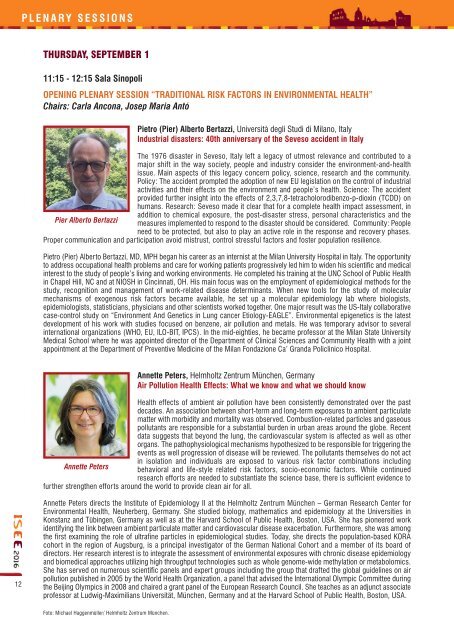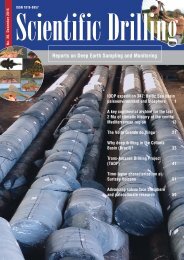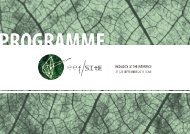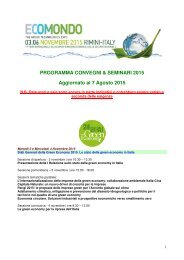Rome Italy
program-bookISEE2016
program-bookISEE2016
You also want an ePaper? Increase the reach of your titles
YUMPU automatically turns print PDFs into web optimized ePapers that Google loves.
PLENARY SESSIONS<br />
THURSDAY, SEPTEMBER 1<br />
11:15 - 12:15 Sala Sinopoli<br />
OPENING PLENARY SESSION “TRADITIONAL RISK FACTORS IN ENVIRONMENTAL HEALTH”<br />
Chairs: Carla Ancona, Josep Maria Antó<br />
Pietro (Pier) Alberto Bertazzi, Università degli Studi di Milano, <strong>Italy</strong><br />
Industrial disasters: 40th anniversary of the Seveso accident in <strong>Italy</strong><br />
The 1976 disaster in Seveso, <strong>Italy</strong> left a legacy of utmost relevance and contributed to a<br />
major shift in the way society, people and industry consider the environment-and-health<br />
issue. Main aspects of this legacy concern policy, science, research and the community.<br />
Policy: The accident prompted the adoption of new EU legislation on the control of industrial<br />
activities and their effects on the environment and people’s health. Science: The accident<br />
provided further insight into the effects of 2,3,7,8-tetracholorodibenzo-p-dioxin (TCDD) on<br />
humans. Research: Seveso made it clear that for a complete health impact assessment, in<br />
addition to chemical exposure, the post-disaster stress, personal characteristics and the<br />
Pier Alberto Bertazzi<br />
measures implemented to respond to the disaster should be considered. Community: People<br />
need to be protected, but also to play an active role in the response and recovery phases.<br />
Proper communication and participation avoid mistrust, control stressful factors and foster population resilience.<br />
Pietro (Pier) Alberto Bertazzi, MD, MPH began his career as an internist at the Milan University Hospital in <strong>Italy</strong>. The opportunity<br />
to address occupational health problems and care for working patients progressively led him to widen his scientific and medical<br />
interest to the study of people’s living and working environments. He completed his training at the UNC School of Public Health<br />
in Chapel Hill, NC and at NIOSH in Cincinnati, OH. His main focus was on the employment of epidemiological methods for the<br />
study, recognition and management of work-related disease determinants. When new tools for the study of molecular<br />
mechanisms of exogenous risk factors became available, he set up a molecular epidemiology lab where biologists,<br />
epidemiologists, statisticians, physicians and other scientists worked together. One major result was the US-<strong>Italy</strong> collaborative<br />
case-control study on “Environment And Genetics in Lung cancer Etiology-EAGLE”. Environmental epigenetics is the latest<br />
development of his work with studies focused on benzene, air pollution and metals. He was temporary advisor to several<br />
international organizations (WHO, EU, ILO-BIT, IPCS). In the mid-eighties, he became professor at the Milan State University<br />
Medical School where he was appointed director of the Department of Clinical Sciences and Community Health with a joint<br />
appointment at the Department of Preventive Medicine of the Milan Fondazione Ca’ Granda Policlinico Hospital.<br />
Annette Peters, Helmholtz Zentrum München, Germany<br />
Air Pollution Health Effects: What we know and what we should know<br />
Health effects of ambient air pollution have been consistently demonstrated over the past<br />
decades. An association between short-term and long-term exposures to ambient particulate<br />
matter with morbidity and mortality was observed. Combustion-related particles and gaseous<br />
pollutants are responsible for a substantial burden in urban areas around the globe. Recent<br />
data suggests that beyond the lung, the cardiovascular system is affected as well as other<br />
organs. The pathophysiological mechanisms hypothesized to be responsible for triggering the<br />
events as well progression of disease will be reviewed. The pollutants themselves do not act<br />
in isolation and individuals are exposed to various risk factor combinations including<br />
Annette Peters behavioral and life-style related risk factors, socio-economic factors. While continued<br />
research efforts are needed to substantiate the science base, there is sufficient evidence to<br />
further strengthen efforts around the world to provide clean air for all.<br />
12<br />
Annette Peters directs the Institute of Epidemiology II at the Helmholtz Zentrum München – German Research Center for<br />
Environmental Health, Neuherberg, Germany. She studied biology, mathematics and epidemiology at the Universities in<br />
Konstanz and Tübingen, Germany as well as at the Harvard School of Public Health, Boston, USA. She has pioneered work<br />
identifying the link between ambient particulate matter and cardiovascular disease exacerbation. Furthermore, she was among<br />
the first examining the role of ultrafine particles in epidemiological studies. Today, she directs the population-based KORA<br />
cohort in the region of Augsburg, is a principal investigator of the German National Cohort and a member of its board of<br />
directors. Her research interest is to integrate the assessment of environmental exposures with chronic disease epidemiology<br />
and biomedical approaches utilizing high throughput technologies such as whole genome-wide methylation or metabolomics.<br />
She has served on numerous scientific panels and expert groups including the group that drafted the global guidelines on air<br />
pollution published in 2005 by the World Health Organization, a panel that advised the International Olympic Committee during<br />
the Beijing Olympics in 2008 and chaired a grant panel of the European Research Council. She teaches as an adjunct associate<br />
professor at Ludwig-Maximilians Universität, München, Germany and at the Harvard School of Public Health, Boston, USA.<br />
Foto: Michael Haggenmüller/ Helmholtz Zentrum München.





